The race to treat post-vaccine blood clots
- Published
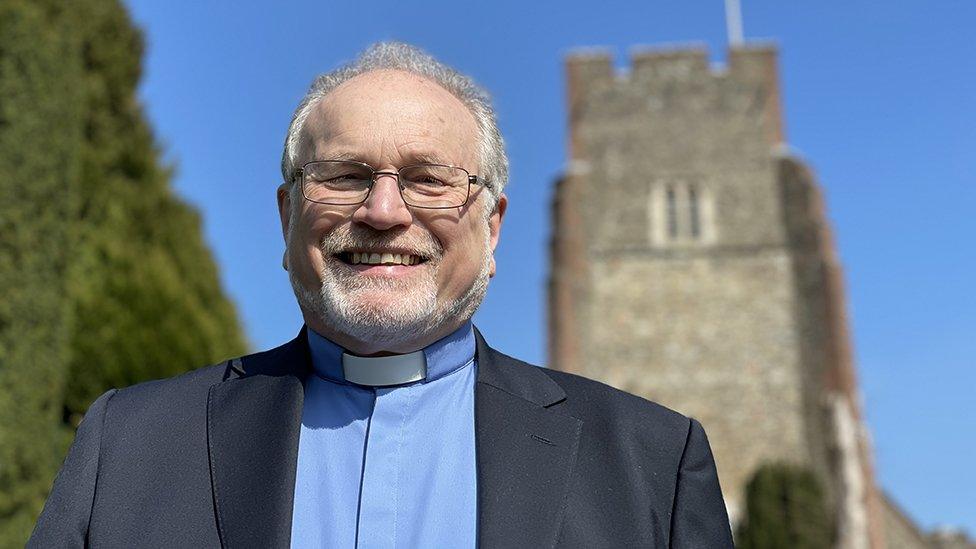

Rev Tim Hatwell is back at work, after being one of the first patients in the UK to develop a post-vaccine blood clot. He's now recovered, thanks to the swift action of doctors in identifying the syndrome and learning how best to treat it.
If Rev Hatwell looks familiar, it could be because you remember him from the comedy film Love Actually. The director, Richard Curtis, wanted a real-life vicar to preside over the marriage of Keira Knightley and Chiwetel Ejiofor, and Rev Hatwell got the part.
We meet at the 900-year-old St Peter's Church, in the village of Ightham, Kent, where he is rector.
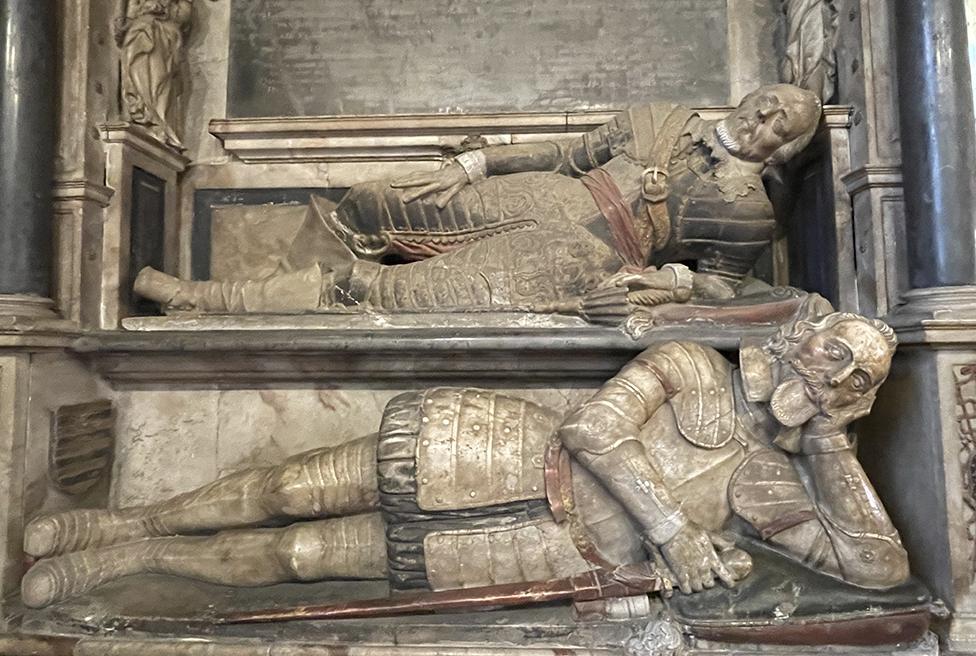
The 900-year-old Norman church contains several beautifully carved memorials
Rev Hatwell, who is 67, had his first dose of the Oxford-AstraZeneca vaccine in early February, and began feeling unwell around 10 days later. He developed flu-like symptoms and initially thought he had Covid. But after two negative tests his condition worsened.
"I had chest pains and thought I might be having a heart attack," he says.
Hospital tests excluded heart trouble and he was discharged. But on the way home his haematologist rang to say he had a very low platelet count and needed to come back.
A CT scan revealed blood clots in his leg and lungs. By now his right leg had become swollen and "extraordinarily painful", making it difficult to walk.
His case report was among the first referred to the medical regulator, the MHRA, which has highlighted a likely link between the Oxford-AstraZeneca vaccine and a rare condition: blood clots combined with low platelets - specialist blood cells which help stop bleeding.
There is still a lot of uncertainty about why the vaccine might be triggering the rare condition, which seems to be the result of an unusual immune response to the jab.
For some reason the body starts producing antibodies against proteins in the platelets. The aggressive immune response leads to platelets becoming overactive, clumping together into clots.
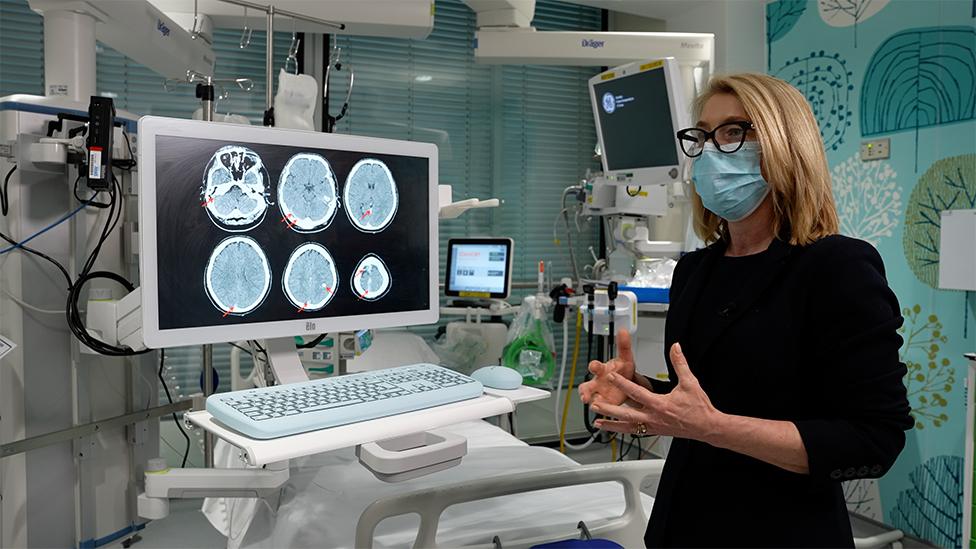
Prof Marie Scully helped to identify the rare condition
Rev Hatwell's consultant contacted Prof Marie Scully, a haematologist at University College London Hospital (UCLH), who helped to identify the rare autoimmune syndrome.
At the beginning of March, she was dealing with a puzzling case - a previously healthy 30-year-old, recently vaccinated, woman admitted with a rare blood clot in the brain and low platelets. The usual diagnostic tests came back negative and the doctors couldn't understand what was wrong. Meanwhile her condition deteriorated.
"Alarm bells rang because this was not in keeping with the situation that we were used to," says Prof Scully.
The woman's symptoms - blood clots combined with low platelet levels - resembled a condition called heparin-induced thrombocytopenia (HIT) a rare reaction to the anticoagulant heparin.
Although this patient hadn't been given heparin, Prof Scully decided to run the test, and to her surprise, it came back positive.
Then she remembered that a few weeks earlier a woman had been admitted to hospital with low platelets and died, despite previously being fit and well. When Prof Scully tested her sample for a key antibody called PF4 which is usually a sign of HIT, it came back positive.
Another colleague in a Birmingham hospital spotted a similar case and this man too, tested positive.
The only thing these three patients had in common was that they had recently received the AstraZeneca vaccine.
"I was extremely surprised about the potential link. It was not something any of us had envisaged," Prof Scully says.
"All the patients were previously fit and well and they suddenly get these low platelets combined with blood clots - often in the brain or liver - and they can deteriorate very quickly."
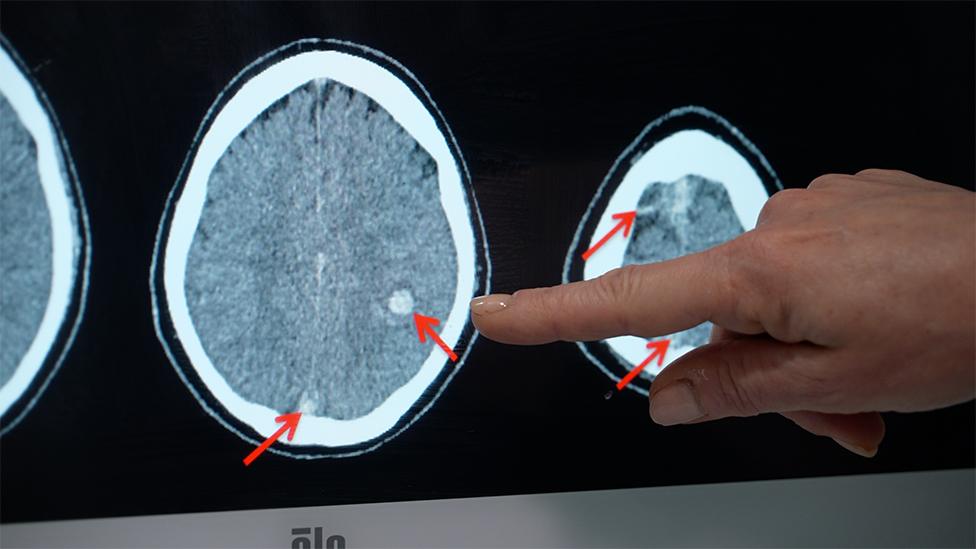
Prof Scully points at MRI scans showing the vaccine-associated thrombosis in the brain
It was potentially a serious complication and the challenge was to find a treatment quickly.
Within a week of the clots issue emerging, the MHRA and Prof Chris Whitty, the Chief Medical Officer for England, were informed, and haematologists across the NHS had been alerted. The experts spoke daily, which allowed them to find answers fast.
"I'm so proud of clinicians because everyone raced to get to the bottom of this and establish guidelines," says Dr Sue Pavord, consultant haematologist at Oxford University Hospitals.
"Very quickly we have brought the death rate down from 50% to 19%."
The condition is known as vaccine-induced thrombosis and thrombocytopenia - VITT for short.
News of how to identify and treat the condition was quickly spread to emergency departments and haematologists. Prof Scully says that's important because it is quite different to how one would normally treat a low platelet count or a blood clot.

So how many cases of VITT have there been in the UK?
A review by the MHRA, external has so far identified 332 cases of these rare, serious blood clots combined with low platelet levels, after 34.9 million doses of the Oxford-AstraZeneca vaccine - up to 19 May 2021
Almost all are after the first shot
The incidence is one in 77,000 after the first dose
The incidence is one in 629,000 after the second dose
There have been 58 deaths - around two per 1.2 million doses
By contrast, there have been 1,900 deaths per million from Covid in the UK

As one of the first patients with the condition, Rev Hatwell benefited from the quick response. He was treated with non-heparin blood thinners and a transfusion of immunoglobulin and his condition gradually improved.
I asked Rev Hatwell what he might say to his congregation about Covid vaccines, in the light of his experience. His faith in immunisation is unshaken.
"In speaking about love for one's neighbour, it seems to me that's a really important aspect of getting the vaccination, because we're not only looking out for ourselves and our own protection, but we're also looking at protecting others."
Rev Tim Hatwell was one of the first patients to develop post-vaccine blood clots
Rev Hatwell says it is "quite a sobering thought" that several of those who've suffered these rare clotting conditions following immunisation have died.
"I do consider myself fortunate, and despite what happened I wouldn't change what I've done. My wife has had the AstraZeneca vaccine without any problems and the risks involved are miniscule."
Prof Scully says there appears to be nothing to link those who succumb to the rare clots.
However, there are indications that it affects younger people more, and under-40s are now being offered the Pfizer or Moderna vaccine as an alternative to Oxford-AstraZeneca.
And as a precaution, the MHRA advises anyone to see medical advice who has symptoms, external four days or more after vaccination such as: a worsening, persistent headache, blurred vision, chest or stomach pain, or unusual bruising beyond the site of the injection.
It is still unclear exactly what causes the reaction, but it does not appear to be linked to the spike protein which produces the antibody, which is common to all vaccines.
Instead, scientists are now looking into a possible link with the vaccine technology.
The AstraZeneca vaccine uses a harmless disabled cold virus to deliver the spike protein. This is what's known as a viral vector vaccine.
The same system is used by the Johnson & Johnson (Janssen) vaccine, and there have also been some cases of blood clots combined with low platelets following immunisation with their vaccine. Use of the vaccine was briefly halted last month in the United States following six cases, one of them fatal, after nearly seven million vaccinations.
 data in detail
data in detail
*Deaths per 100,000 people
| US | 1,012,833 | 308.6 | 87,030,788 | ||
| Brazil | 672,033 | 318.4 | 32,535,923 | ||
| India | 525,242 | 38.4 | 43,531,650 | ||
| Russia | 373,595 | 258.8 | 18,173,480 | ||
| Mexico | 325,793 | 255.4 | 6,093,835 | ||
| Peru | 213,579 | 657.0 | 3,640,061 | ||
| UK | 177,890 | 266.2 | 22,232,377 | ||
| Italy | 168,604 | 279.6 | 18,805,756 | ||
| Indonesia | 156,758 | 57.9 | 6,095,351 | ||
| France | 146,406 | 218.3 | 30,584,880 | ||
| Iran | 141,404 | 170.5 | 7,240,564 | ||
| Germany | 141,397 | 170.1 | 28,542,484 | ||
| Colombia | 140,070 | 278.3 | 6,175,181 | ||
| Argentina | 129,109 | 287.3 | 9,394,326 | ||
| Poland | 116,435 | 306.6 | 6,016,526 | ||
| Ukraine | 112,459 | 253.4 | 5,040,518 | ||
| Spain | 108,111 | 229.6 | 12,818,184 | ||
| South Africa | 101,812 | 173.9 | 3,995,291 | ||
| Turkey | 99,057 | 118.7 | 15,180,444 | ||
| Romania | 65,755 | 339.7 | 2,927,187 | ||
| Philippines | 60,602 | 56.1 | 3,709,386 | ||
| Chile | 58,617 | 309.3 | 4,030,267 | ||
| Hungary | 46,647 | 477.5 | 1,928,125 | ||
| Vietnam | 43,088 | 44.7 | 10,749,324 | ||
| Canada | 42,001 | 111.7 | 3,958,155 | ||
| Czech Republic | 40,324 | 377.9 | 3,936,870 | ||
| Bulgaria | 37,260 | 534.1 | 1,174,216 | ||
| Malaysia | 35,784 | 112.0 | 4,575,809 | ||
| Ecuador | 35,745 | 205.7 | 913,798 | ||
| Belgium | 31,952 | 278.2 | 4,265,296 | ||
| Japan | 31,328 | 24.8 | 9,405,007 | ||
| Thailand | 30,736 | 44.1 | 4,534,017 | ||
| Pakistan | 30,403 | 14.0 | 1,539,275 | ||
| Greece | 30,327 | 283.0 | 3,729,199 | ||
| Bangladesh | 29,174 | 17.9 | 1,980,974 | ||
| Tunisia | 28,691 | 245.3 | 1,052,180 | ||
| Iraq | 25,247 | 64.2 | 2,359,755 | ||
| Egypt | 24,723 | 24.6 | 515,645 | ||
| South Korea | 24,576 | 47.5 | 18,413,997 | ||
| Portugal | 24,149 | 235.2 | 5,171,236 | ||
| Netherlands | 22,383 | 129.1 | 8,203,898 | ||
| Bolivia | 21,958 | 190.7 | 931,955 | ||
| Slovakia | 20,147 | 369.4 | 2,551,116 | ||
| Austria | 20,068 | 226.1 | 4,499,570 | ||
| Myanmar | 19,434 | 36.0 | 613,659 | ||
| Sweden | 19,124 | 185.9 | 2,519,199 | ||
| Kazakhstan | 19,018 | 102.7 | 1,396,584 | ||
| Paraguay | 18,994 | 269.6 | 660,841 | ||
| Guatemala | 18,616 | 112.1 | 921,146 | ||
| Georgia | 16,841 | 452.7 | 1,660,429 | ||
| Sri Lanka | 16,522 | 75.8 | 664,181 | ||
| Serbia | 16,132 | 232.3 | 2,033,180 | ||
| Morocco | 16,120 | 44.2 | 1,226,246 | ||
| Croatia | 16,082 | 395.4 | 1,151,523 | ||
| Bosnia and Herzegovina | 15,807 | 478.9 | 379,041 | ||
| China | 14,633 | 1.0 | 2,144,566 | ||
| Jordan | 14,068 | 139.3 | 1,700,526 | ||
| Switzerland | 13,833 | 161.3 | 3,759,730 | ||
| Nepal | 11,952 | 41.8 | 979,835 | ||
| Moldova | 11,567 | 435.2 | 520,321 | ||
| Israel | 10,984 | 121.3 | 4,391,275 | ||
| Honduras | 10,906 | 111.9 | 427,718 | ||
| Lebanon | 10,469 | 152.7 | 1,116,798 | ||
| Australia | 10,085 | 39.8 | 8,291,399 | ||
| Azerbaijan | 9,717 | 96.9 | 793,388 | ||
| North Macedonia | 9,327 | 447.7 | 314,501 | ||
| Saudi Arabia | 9,211 | 26.9 | 797,374 | ||
| Lithuania | 9,175 | 329.2 | 1,162,184 | ||
| Armenia | 8,629 | 291.7 | 423,417 | ||
| Cuba | 8,529 | 75.3 | 1,106,167 | ||
| Costa Rica | 8,525 | 168.9 | 904,934 | ||
| Panama | 8,373 | 197.2 | 925,254 | ||
| Afghanistan | 7,725 | 20.3 | 182,793 | ||
| Ethiopia | 7,542 | 6.7 | 489,502 | ||
| Ireland | 7,499 | 151.8 | 1,600,614 | ||
| Uruguay | 7,331 | 211.8 | 957,629 | ||
| Taiwan | 7,025 | 29.5 | 3,893,643 | ||
| Belarus | 6,978 | 73.7 | 982,867 | ||
| Algeria | 6,875 | 16.0 | 266,173 | ||
| Slovenia | 6,655 | 318.7 | 1,041,426 | ||
| Denmark | 6,487 | 111.5 | 3,177,491 | ||
| Libya | 6,430 | 94.9 | 502,189 | ||
| Latvia | 5,860 | 306.4 | 837,182 | ||
| Venezuela | 5,735 | 20.1 | 527,074 | ||
| Palestinian Territories | 5,662 | 120.8 | 662,490 | ||
| Kenya | 5,656 | 10.8 | 334,551 | ||
| Zimbabwe | 5,558 | 38.0 | 255,726 | ||
| Sudan | 4,952 | 11.6 | 62,696 | ||
| Finland | 4,875 | 88.3 | 1,145,610 | ||
| Oman | 4,628 | 93.0 | 390,244 | ||
| Dominican Republic | 4,383 | 40.8 | 611,581 | ||
| El Salvador | 4,150 | 64.3 | 169,646 | ||
| Namibia | 4,065 | 163.0 | 169,247 | ||
| Trinidad and Tobago | 4,013 | 287.7 | 167,495 | ||
| Zambia | 4,007 | 22.4 | 326,259 | ||
| Uganda | 3,621 | 8.2 | 167,979 | ||
| Albania | 3,502 | 122.7 | 282,690 | ||
| Norway | 3,337 | 62.4 | 1,448,679 | ||
| Syria | 3,150 | 18.5 | 55,934 | ||
| Nigeria | 3,144 | 1.6 | 257,637 | ||
| Jamaica | 3,144 | 106.6 | 143,347 | ||
| Kosovo | 3,140 | 175.0 | 229,841 | ||
| Cambodia | 3,056 | 18.5 | 136,296 | ||
| Kyrgyzstan | 2,991 | 46.3 | 201,101 | ||
| Botswana | 2,750 | 119.4 | 322,769 | ||
| Montenegro | 2,729 | 438.6 | 241,190 | ||
| Malawi | 2,646 | 14.2 | 86,600 | ||
| Estonia | 2,591 | 195.3 | 580,114 | ||
| Kuwait | 2,555 | 60.7 | 644,451 | ||
| United Arab Emirates | 2,319 | 23.7 | 952,960 | ||
| Mozambique | 2,212 | 7.3 | 228,226 | ||
| Mongolia | 2,179 | 67.6 | 928,981 | ||
| Yemen | 2,149 | 7.4 | 11,832 | ||
| Senegal | 1,968 | 12.1 | 86,382 | ||
| Cameroon | 1,931 | 7.5 | 120,068 | ||
| Angola | 1,900 | 6.0 | 101,320 | ||
| Uzbekistan | 1,637 | 4.9 | 241,196 | ||
| New Zealand | 1,534 | 31.2 | 1,374,535 | ||
| Bahrain | 1,495 | 91.1 | 631,562 | ||
| Rwanda | 1,460 | 11.6 | 131,270 | ||
| Ghana | 1,452 | 4.8 | 166,546 | ||
| Singapore | 1,419 | 24.9 | 1,473,180 | ||
| Eswatini | 1,416 | 123.3 | 73,148 | ||
| Madagascar | 1,401 | 5.2 | 65,787 | ||
| DR Congo | 1,375 | 1.6 | 91,393 | ||
| Suriname | 1,369 | 235.5 | 80,864 | ||
| Somalia | 1,361 | 8.8 | 26,803 | ||
| Guyana | 1,256 | 160.5 | 67,657 | ||
| Luxembourg | 1,094 | 176.5 | 265,323 | ||
| Cyprus | 1,075 | 89.7 | 515,596 | ||
| Mauritius | 1,004 | 79.3 | 231,036 | ||
| Mauritania | 984 | 21.7 | 60,368 | ||
| Martinique | 965 | 257.0 | 195,912 | ||
| Guadeloupe | 955 | 238.7 | 168,714 | ||
| Fiji | 866 | 97.3 | 65,889 | ||
| Tanzania | 841 | 1.4 | 35,768 | ||
| Haiti | 837 | 7.4 | 31,677 | ||
| Bahamas | 820 | 210.5 | 36,101 | ||
| Réunion | 812 | 91.3 | 422,769 | ||
| Ivory Coast | 805 | 3.1 | 83,679 | ||
| Laos | 757 | 10.6 | 210,313 | ||
| Malta | 748 | 148.8 | 105,407 | ||
| Mali | 737 | 3.7 | 31,176 | ||
| Lesotho | 699 | 32.9 | 33,938 | ||
| Belize | 680 | 174.2 | 64,371 | ||
| Qatar | 679 | 24.0 | 385,163 | ||
| Papua New Guinea | 662 | 7.5 | 44,728 | ||
| French Polynesia | 649 | 232.4 | 73,386 | ||
| Barbados | 477 | 166.2 | 84,919 | ||
| Guinea | 443 | 3.5 | 37,123 | ||
| Cape Verde | 405 | 73.6 | 61,105 | ||
| French Guiana | 401 | 137.9 | 86,911 | ||
| Burkina Faso | 387 | 1.9 | 21,044 | ||
| Congo | 385 | 7.2 | 24,128 | ||
| Saint Lucia | 383 | 209.5 | 27,094 | ||
| Gambia | 365 | 15.5 | 12,002 | ||
| New Caledonia | 313 | 108.8 | 64,337 | ||
| Niger | 310 | 1.3 | 9,031 | ||
| Maldives | 306 | 57.6 | 182,720 | ||
| Gabon | 305 | 14.0 | 47,939 | ||
| Liberia | 294 | 6.0 | 7,497 | ||
| Curaçao | 278 | 176.5 | 44,545 | ||
| Togo | 275 | 3.4 | 37,482 | ||
| Nicaragua | 242 | 3.7 | 14,690 | ||
| Grenada | 232 | 207.1 | 18,376 | ||
| Brunei | 225 | 51.9 | 167,669 | ||
| Aruba | 222 | 208.8 | 41,000 | ||
| Chad | 193 | 1.2 | 7,426 | ||
| Djibouti | 189 | 19.4 | 15,690 | ||
| Mayotte | 187 | 70.3 | 37,958 | ||
| Equatorial Guinea | 183 | 13.5 | 16,114 | ||
| Iceland | 179 | 49.5 | 195,259 | ||
| Channel Islands | 179 | 103.9 | 80,990 | ||
| Guinea-Bissau | 171 | 8.9 | 8,369 | ||
| Seychelles | 167 | 171.1 | 44,847 | ||
| Benin | 163 | 1.4 | 27,216 | ||
| Comoros | 160 | 18.8 | 8,161 | ||
| Andorra | 153 | 198.3 | 44,177 | ||
| Solomon Islands | 153 | 22.8 | 21,544 | ||
| Antigua and Barbuda | 141 | 145.2 | 8,665 | ||
| Bermuda | 140 | 219.0 | 16,162 | ||
| South Sudan | 138 | 1.2 | 17,722 | ||
| Timor-Leste | 133 | 10.3 | 22,959 | ||
| Tajikistan | 125 | 1.3 | 17,786 | ||
| Sierra Leone | 125 | 1.6 | 7,704 | ||
| San Marino | 115 | 339.6 | 18,236 | ||
| St Vincent and the Grenadines | 114 | 103.1 | 9,058 | ||
| Central African Republic | 113 | 2.4 | 14,649 | ||
| Isle of Man | 108 | 127.7 | 36,463 | ||
| Gibraltar | 104 | 308.6 | 19,633 | ||
| Eritrea | 103 | 2.9 | 9,805 | ||
| Sint Maarten | 87 | 213.6 | 10,601 | ||
| Liechtenstein | 85 | 223.6 | 17,935 | ||
| Sao Tome and Principe | 74 | 34.4 | 6,064 | ||
| Dominica | 68 | 94.7 | 14,852 | ||
| Saint Martin | 63 | 165.8 | 10,952 | ||
| British Virgin Islands | 63 | 209.8 | 6,941 | ||
| Monaco | 59 | 151.4 | 13,100 | ||
| Saint Kitts and Nevis | 43 | 81.4 | 6,157 | ||
| Burundi | 38 | 0.3 | 42,731 | ||
| Bonaire, Sint Eustatius and Saba | 37 | 142.4 | 10,405 | ||
| Turks and Caicos Islands | 36 | 94.3 | 6,219 | ||
| Cayman Islands | 29 | 44.7 | 27,594 | ||
| Samoa | 29 | 14.7 | 14,995 | ||
| Faroe Islands | 28 | 57.5 | 34,658 | ||
| Bhutan | 21 | 2.8 | 59,824 | ||
| Greenland | 21 | 37.3 | 11,971 | ||
| Vanuatu | 14 | 4.7 | 11,389 | ||
| Kiribati | 13 | 11.1 | 3,236 | ||
| Diamond Princess cruise ship | 13 | 712 | |||
| Tonga | 12 | 11.5 | 12,301 | ||
| Anguilla | 9 | 60.5 | 3,476 | ||
| Montserrat | 8 | 160.3 | 1,020 | ||
| Wallis and Futuna Islands | 7 | 61.2 | 454 | ||
| Palau | 6 | 33.3 | 5,237 | ||
| Saint Barthelemy | 6 | 60.9 | 4,697 | ||
| MS Zaandam cruise ship | 2 | 9 | |||
| Cook Islands | 1 | 5.7 | 5,774 | ||
| Saint Pierre and Miquelon | 1 | 17.2 | 2,779 | ||
| Falkland Islands | 0 | 0.0 | 1,815 | ||
| Micronesia | 0 | 0.0 | 38 | ||
| Vatican | 0 | 0.0 | 29 | ||
| Marshall Islands | 0 | 0.0 | 18 | ||
| Antarctica | 0 | 11 | |||
| Saint Helena | 0 | 0.0 | 4 |
Please update your browser to see full interactive
This information is regularly updated but may not reflect the latest totals for each country.
** The past data for new cases is a three day rolling average. Due to revisions in the number of cases, an average cannot be calculated for this date.
Source: Johns Hopkins University and national public health agencies
Figures last updated: 5 July 2022, 08:59 BST
Note: This table, from the BBC's global tracker, will be updated over time.
There is always a balance to be struck between informing the public about a rare potential side-effect of the AstraZeneca vaccine without undermining confidence in a potentially life-saving jab. It's estimated Covid vaccines have already prevented around 13,000 deaths and nearly 40,000 hospitalisations in the UK.
Unlike Pfizer and Moderna, AstraZeneca are providing their Covid vaccine on a not-for-profit basis. It is also easier to store and transport than other vaccines, adding to its vital global role. Over 450 million doses have been distributed so far worldwide.
Prof Scully is also keen to stress the crucial role vaccines are playing in controlling the pandemic: "Vaccination is paramount. It is the only way we are going to get on top of Covid. We have to balance the risk of mortality from Covid versus the incidence of this rare condition."
Follow @BBCFergusWalsh, external on Twitter

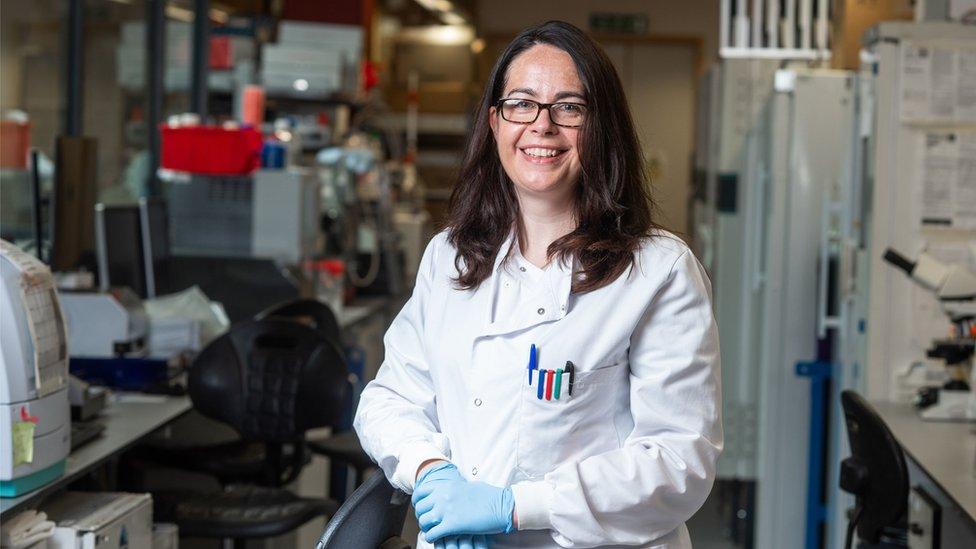
Prof Teresa Lambe, who designed the vaccine over a weekend
The journey to create a vaccine at lightning speed. Bogus reports, accidental finds - the Oxford vaccine story